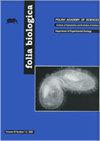In vitroSodium Fluoride Treatment Significantly Affects Apoptosis and Proliferation in the Liver of Embryonic Chickens
IF 0.8
4区 生物学
Q4 BIOLOGY
引用次数: 0
Abstract
Sodium fluoride (NaF), although helpful in preventing dental decay, may negatively affect the body. The aim of this study was to examine the effects of a 6-h in vitro treatment of livers isolated from 14-day-old chicken embryos with NaF at doses of 1.7 (D1), 3.5 (D2), 7.1 (D3) and 14.2 mM (D4), with regard to apoptosis, cell proliferation and tissue structure. The mRNA expression of the apoptosis regulators CYCS, APAF1, BCL2, CASP3, CASP9 and TMBIM1 was analysed by the qPCR method. Apoptotic cells were detected by a TUNEL assay. The tissue and DNA structure were also analysed by histological staining (H&E, Feulgen). The number of proliferating cells was determined and the apoptosis regulatory proteins were localised by the immunohistochemical staining of PCNA, CASP3 and APAF1. The results showed that the mRNA expression of CYCS, BCL2, CASP3, CASP9 and APAF1 increased significantly in the D1 group, as did that of CASP9 in the D3 group and of BCL2 and APAF1 in the D4 group. The number of apoptotic cells increased significantly in the D4 group, where they increased from 18% to 49%. On the other hand, the number of proliferating cells decreased gradually, in a dose-dependent manner, from 84% in the control group to 5.5% in the D4 group. The expression of apoptosis-regulating factors also increased: in the D3 and D4 groups, the CASP3 immunopositive reaction was more intensive in single cells in the embryonic livers, whereas that of APAF1 increased in the hepatocytes as well as in the hepatic blood vessel walls. The mechanism of the effect of NaF on apoptosis in the embryonic liver is very complex. In the groups exposed to higher doses of NaF, apoptosis was significantly stimulated, while proliferation was inhibited and the tissue structure was damaged. The expression of apoptosis regulators at the mRNA and protein levels increased, but the mRNA expression did not depend on the NaF dose. These results reveal that NaF, by changing the balance between apoptosis and the proliferation of hepatocytes, may disturb the development and function of the liver in embryonic chickens. Therefore, the risk of exposure to NaF should be considered when determining the standards for human and animal exposure to this compound.体外氟化钠治疗对胚胎鸡肝脏细胞凋亡和增殖的影响
氟化钠(NaF)虽然有助于预防蛀牙,但可能对身体产生负面影响。本研究的目的是检验用1.7(D1)、3.5(D2)、7.1(D3)和14.2mM(D4)剂量的NaF对从14天大的鸡胚中分离的肝脏进行6小时体外处理对细胞凋亡、细胞增殖和组织结构的影响。通过qPCR方法分析细胞凋亡调节因子CYCS、APAF1、BCL2、CASP3、CASP9和TMBIM1的mRNA表达。通过TUNEL测定法检测凋亡细胞。还通过组织学染色(H&E,Feulgen)分析了组织和DNA结构。通过PCNA、CASP3和APAF1的免疫组织化学染色测定增殖细胞的数量并定位凋亡调节蛋白。结果显示,D1组中CYCS、BCL2、CASP3、CASP9和APAF1的mRNA表达显著增加,D3组中CASP9以及D4组中BCL2和APAF1也显著增加。D4组的凋亡细胞数量显著增加,从18%增加到49%。另一方面,增殖细胞的数量以剂量依赖的方式逐渐减少,从对照组的84%减少到D4组的5.5%。凋亡调节因子的表达也增加:在D3和D4组中,胚胎肝脏的单细胞中CASP3免疫阳性反应更强烈,而APAF1在肝细胞和肝血管壁中的免疫阳性反应增加。NaF对胚胎肝细胞凋亡的作用机制非常复杂。在暴露于高剂量NaF的组中,细胞凋亡受到显著刺激,而增殖受到抑制,组织结构受损。凋亡调节因子在mRNA和蛋白质水平上的表达增加,但mRNA表达不依赖于NaF剂量。这些结果表明,NaF通过改变肝细胞凋亡和增殖之间的平衡,可能会干扰胚胎鸡肝脏的发育和功能。因此,在确定人类和动物接触该化合物的标准时,应考虑接触NaF的风险。
本文章由计算机程序翻译,如有差异,请以英文原文为准。
求助全文
约1分钟内获得全文
求助全文
来源期刊

Folia Biologica-Krakow
医学-生物学
CiteScore
1.10
自引率
14.30%
发文量
15
审稿时长
>12 weeks
期刊介绍:
Folia Biologica (Kraków) is an international online open access journal accepting original scientific articles on various aspects of zoology: phylogeny, genetics, chromosomal studies, ecology, biogeography, experimental zoology and ultrastructural studies. The language of publication is English, articles are assembled in four issues per year.
 求助内容:
求助内容: 应助结果提醒方式:
应助结果提醒方式:


